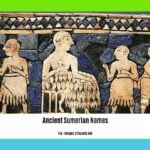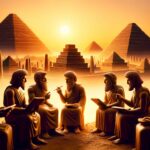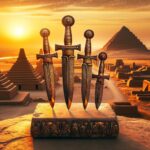Unveiling Mesopotamian Cosmology: Exploring the Myths, Celestial Observations, and Divine Interactions takes readers on an enthralling journey into the depths of ancient civilizations. Delving into the intricate belief systems of Mesopotamia, this article captures the essence of their cosmological worldview. From their captivating myths to their profound celestial observations, we uncover the interplay between gods and humans within the cosmic narratives of this fascinating civilization.
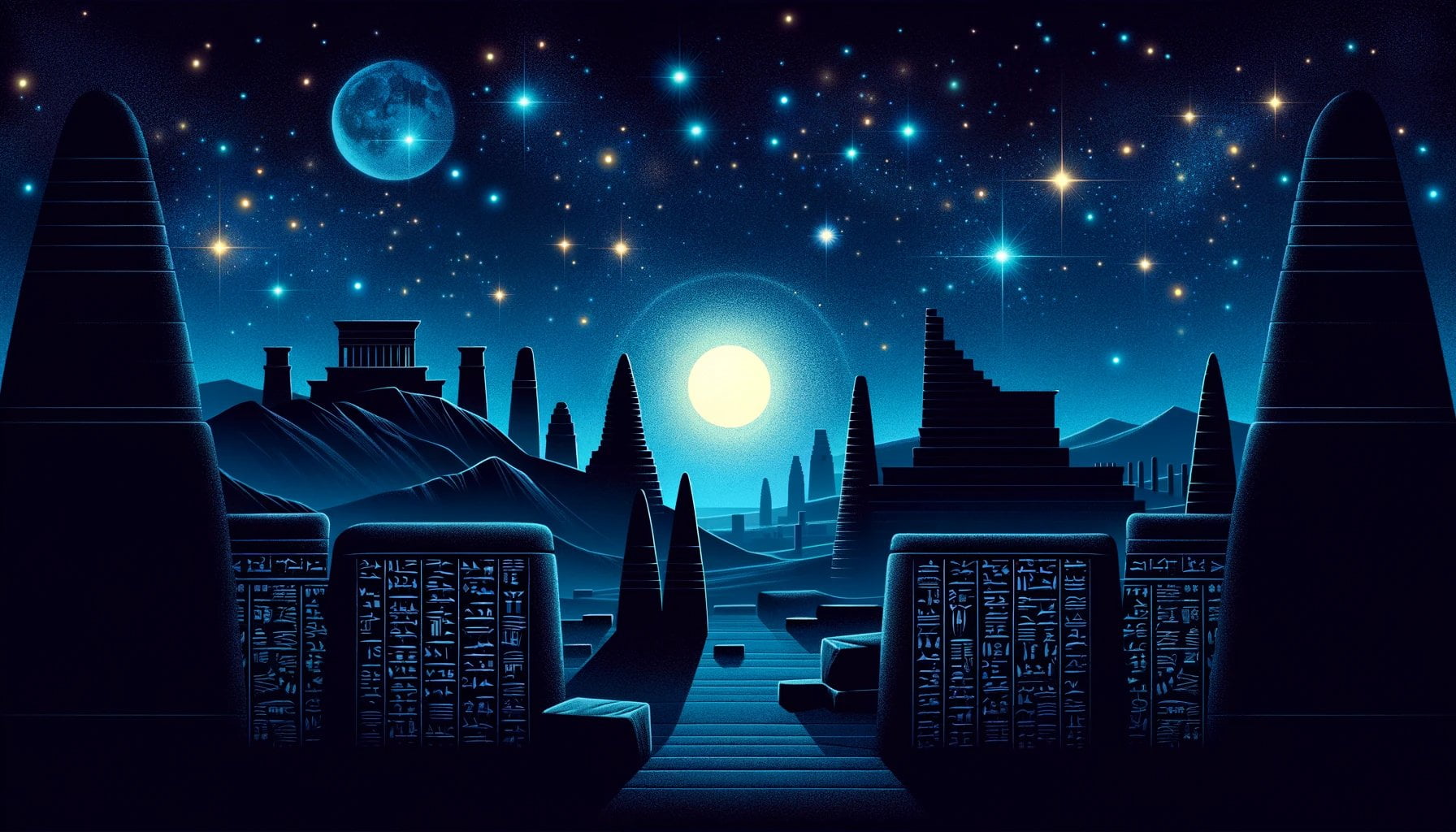
Key Takeaways:
- Babylonian cosmology is based on Babylonian mythology and Babylonian astronomy.
- The cosmology of ancient Mesopotamia can be reconstructed using sources such as Sumerian and Akkadian mythology, hymns, celestial divination, and astronomical observations.
- The myth Enuma Elish is a well-known story that explores Mesopotamian cosmology.
- Unlike Sumerian cosmology, Babylonian cosmology believed that the heavens and the earth were circular and connected.
- There is limited information available about the cosmology and worldview of ancient Babylonian astrologers and astronomers.
- Ancient Mesopotamian cosmology depicted the Earth as a flat, circular object surrounded by a cosmic ocean.
- The study of Mesopotamian cosmology was primarily a theological inquiry rather than a part of Babylonian science.
- Author Francesca Rochberg has written extensively on Mesopotamian cosmology.
- Mesopotamian cosmology has been a subject of interest for both scholars and laymen since the decipherment of cuneiform script in the 19th century.
Mesopotamian Cosmology
Mesopotamia, the land between the Tigris and Euphrates rivers, was home to one of the oldest civilizations in the world. Within the realm of ancient Mesopotamian beliefs and practices, their understanding of the cosmos played a significant role. Through a combination of mythology, hymns, celestial divination, and astronomical observations, we can reconstruct their fascinating cosmological beliefs.
Understanding the Universe
In Mesopotamian cosmology, the Earth was visualized as a flat and circular entity, surrounded by a cosmic ocean. This ocean was believed to enclose the Earth and extend indefinitely beyond it, connecting with the heavenly realms above. The heavens were seen as multiple tiers, with the stars, planets, and other celestial bodies occupying different levels.
The cosmos, according to Mesopotamian cosmology, consisted of the earthly realm, the celestial realm, and the underworld. It was an intricately layered universe, with each realm housing various divine beings and interacting with one another.
The Divine Interplay
The Mesopotamians attributed immense importance to their gods and goddesses, who occupied prominent roles in their cosmology. These divine beings were believed to shape and influence the cosmos, guiding its functions and maintaining cosmic order. Their interactions with humans were often depicted in myths and legends that revealed the connections between the mortal and divine realms.
One of the most well-known myths dealing with Mesopotamian cosmology is the Enuma Elish. This epic tale narrates the creation of the universe, with gods and goddesses battling for supremacy and establishing their cosmic domains. Through such myths, the Mesopotamians explored the origins of the cosmos and the forces behind its existence.
Celestial Observations
Astronomy played a significant role in Mesopotamian cosmology. They observed and recorded celestial events such as eclipses, planetary movements, and comets. These observations were not only important for practical purposes like agriculture and navigation but also held deep religious and symbolic meanings.
Astrology, the belief in celestial influence on human affairs, was closely intertwined with Mesopotamian cosmology. The Mesopotamians believed that by studying the movements and positions of celestial bodies, they could gain insights into the intentions of the gods and make predictions about the future.
Babylonian Cosmology
Babylonian cosmology, a subset of Mesopotamian cosmology, flourished under the Babylonian empire. It built upon the earlier Sumerian cosmology but introduced some notable differences. Babylonian cosmology focused on the concept of circular motion in the heavens, with the heavens and the earth considered equal and joined as a unified whole.
While ancient Babylonian astrologers and astronomers have left fewer traces compared to other ancient civilizations, their practices and beliefs influenced later civilizations such as the Greeks. Despite the limited knowledge we have of their cosmology, the decipherment of cuneiform script in the 19th century sparked renewed interest in the subject among scholars and laymen alike.
Unraveling the Mysteries
Mesopotamian cosmology remains a captivating subject, intriguing scholars and enthusiasts alike. Its complexities lie not only in the ancient myths and beliefs surrounding the universe but also in the interplay between gods and humans and the practical applications of celestial observations.
By delving into the rich tapestry of Mesopotamian cosmology, we gain a deeper understanding of the cultural and religious practices that shaped their worldview. From their unique perspective on the universe to their intricate celestial observations, this ancient civilization presents us with a world of myths and wonders waiting to be unveiled.
Sources:
1. Wikipedia: Babylonian Cosmology
2. Wiley Online Library: Mesopotamian Cosmology
Mesopotamian astronomy was an ancient practice filled with mystery and wonder. Discover more about this fascinating subject by clicking on mesopotamian astronomy.
The art of crafting mesopotamian swords was unparalleled, with intricate designs and superb craftsmanship. Explore the world of these legendary weapons by clicking on mesopotamian swords.
Curious about the characteristic features of mesopotamian architecture? Click on what is a characteristic of mesopotamian architecture to delve into the secrets behind this awe-inspiring style.
Mesopotamian philosophers were the intellectual thinkers of their time, pondering life’s greatest questions. Learn about their wisdom and philosophies by clicking on mesopotamian philosophers.
Discover the outstanding achievements of the Mesopotamian civilization by clicking on what are some mesopotamian achievements. From inventions to cultural innovations, prepare to be amazed.
Economics played a crucial role in shaping the ancient Mesopotamian society. Delve into the fascinating world of economics in Mesopotamia and explore the foundations of their economic systems.
The Role of Deities in Mesopotamian Cosmology
What can the ancient Mesopotamian beliefs about cosmology teach us about the role of deities in shaping their worldview? Let’s delve into the myths, celestial observations, and cosmic narratives of the Mesopotamians to uncover the significance of deities in their cosmological beliefs.
An Intricate Tapestry of Gods and Humans
In Mesopotamian cosmology, deities played a central role in the creation, structure, and workings of the universe. The general consensus was that the universe was an ordered and purposeful creation brought into existence by these gods. But who were these deities, and what powers did they possess?
Mesopotamian religion had a democratic flavor, with gods organized as a landed nobility. Various gods held different powers and had unique agendas, making their interactions intricate and multifaceted. These divine beings were not distant rulers but rather active participants in the lives of both gods and humans, shaping their destinies and playing a key role in their cosmic narratives.
Exploring Mesopotamian Mythology
Mesopotamian myth provides valuable insights into the relationships between gods and humans, shedding light on fundamental aspects of human existence. Creation, birth, sexuality, and death were important themes woven into their narratives, exploring the complexities of what it means to be human.
The oldest known materials on Mesopotamian cosmology are the Sumerian myths, offering a glimpse into their creation beliefs. These myths, along with subsequent tales and disputations, provide invaluable clues about the Mesopotamian understanding of cosmology.
Special Bonds with the Divine
In Mesopotamian culture, heroes and kings held a special position, often forming intimate bonds with the divine. These individuals were seen as bridges between the mortal and divine realms, aligning themselves with gods and receiving their blessings – a testament to the close interaction between deities and humans within the cosmic framework.
The Interplay of Deities and Demons
While gods held prominent positions in Mesopotamian myths, demons played a relatively minor role. The focus was primarily on the pantheon of gods and their relationships with one another and with humanity. By studying the list of deities in Mesopotamian cosmology, we can better understand the merging of ancestral traditions and the rise of chief deities within their belief systems.
A Cultural Legacy
Mesopotamian cosmology has left a lasting impact on later civilizations and continues to captivate scholars and enthusiasts. By studying the myths, celestial observations, and the interplay between gods and humans in Mesopotamian cosmology, we gain valuable insights into a profound and sophisticated ancient worldview that shaped the development of human civilizations.
Key Takeaways:
- Deities played a central role in shaping the Mesopotamian worldview and cosmology.
- Mesopotamian myths explore the relationships between gods and humans, delving into fundamental aspects of human existence.
- Heroes and kings held special bonds with the divine, acting as intermediaries between gods and humanity.
- Demons played a minor role in Mesopotamian myths, while the focus remained on the pantheon of deities.
- The cultural legacy of Mesopotamian cosmology has influenced later civilizations and continues to fascinate scholars and enthusiasts.
Sources:
- Mesopotamian Cosmogony and Cosmology by Wayne Horowitz
- An Analysis of the Roles and Relationships Between Cosmology by Clinton Briar
Creation Myths and the Origins of the Universe in Mesopotamian Cosmology
In the fascinating realm of Mesopotamian cosmology, creation myths offer a window into the ancient beliefs and understandings of the origins of the universe. While not scientific explanations, these myths provide a cultural and symbolic interpretation of how the universe came into existence.
One of the most well-known Mesopotamian creation epics is Enuma Elish, which recounts the story of Marduk, the chief god of Babylon. In this epic, Marduk triumphs over the elder goddess Tiamat, bringing order to chaos and establishing himself as the Lord of the Gods of Heaven and Earth[^2]. The Enuma Elish is a significant source for understanding Mesopotamian creation myths.
Mesopotamian cosmology and mythology can be explored through the analysis of Sumerian and Akkadian mythology, hymns, celestial divination, and astronomical texts[^3]. These sources provide valuable insights into the ancient beliefs about the origins of the universe.
While Mesopotamian cosmology primarily focused on the origins and functions of the gods, studying creation myths and cosmological accounts can unveil the ancient mindset and worldview. These accounts may not provide scientific explanations, but they shed light on the cultural and symbolic understanding of the universe’s creation.
If you’re interested in delving deeper into the subject of Mesopotamian cosmology and creation myths, there are several valuable resources available:
- The Metropolitan Museum of Art offers an essay on Mesopotamian Creation Myths. This comprehensive resource provides in-depth information about the topic[^1].
- Francesca Rochberg, a scholar in the field, has conducted research exploring Mesopotamian cosmology through the analysis of Sumerian and Akkadian mythology. Her work offers valuable insights into the ancient beliefs about the origins of the universe[^3].
- Encyclopedia Britannica provides a detailed overview of the Enuma Elish epic. This source offers an in-depth analysis of this ancient Mesopotamian creation myth[^2].
These resources provide a wealth of information for anyone seeking to uncover the mysteries of Mesopotamian cosmology and the origins of the universe.
Key Takeaways:
- Mesopotamian cosmology is filled with creation myths that offer cultural and symbolic interpretations of the universe’s origins.
- The Enuma Elish is one of the most prominent Mesopotamian creation epics, telling the story of Marduk’s triumph over chaos.
- Studying Sumerian and Akkadian mythology, hymns, celestial divination, and astronomical texts provides valuable insights into Mesopotamian cosmology.
- Mesopotamian cosmology focused more on the gods’ origins and functions rather than the processes of the universe.
- The creation myths and cosmological accounts provide a glimpse into the ancient mindset and worldview, although they are not scientific explanations.
References:
[^1]: The Metropolitan Museum of Art. Mesopotamian Creation Myths
[^2]: Encyclopedia Britannica. Enuma elish. Link
[^3]: Rochberg, F. (2020). Mesopotamian Cosmology. In A Companion to the Ancient Near East. Wiley Online Library. Link
Celestial Observations and their Significance in Mesopotamian Cosmology
In ancient Mesopotamia, the study of celestial observations held immense significance in shaping their cosmological beliefs. The Mesopotamians meticulously observed and studied the celestial bodies, including the Moon, planets, stars, and other celestial phenomena, which intertwined religious, astrological, and astronomical aspects. This article explores the profound importance of celestial observations in Mesopotamian cosmology and sheds light on the myths, celestial divination, and divine interactions that were influenced by these observations.
The Significance of Celestial Observations in Mesopotamian Culture
Celestial divination played a vital role in the fabric of Mesopotamian society. The Mesopotamians believed that celestial events held religious and symbolic meanings, providing insights into the desires and intentions of the gods. By meticulously observing the movements and alignments of celestial bodies, they sought to gain knowledge about the divine order and foresee future events. This intricate practice allowed them to interpret celestial phenomena as omens, which influenced their decision-making processes and guided their actions.
The Knowledge and Significance of Celestial Objects
To gain a comprehensive understanding of the significance of celestial observations in Mesopotamian cosmology, it is crucial to explore the knowledge and importance placed on celestial objects. The Mesopotamians possessed a deep understanding of the Moon and the planets visible to the naked eye, along with the Sun, stars, and other celestial phenomena. They recognized the cyclical patterns and movements of these celestial bodies, which led to the development of complex astronomical and astrological systems.
ResearchGate provides a comprehensive study on the Moon and planets in ancient Mesopotamia, incorporating both textual and iconographical sources. This study delves into the Mesopotamians’ knowledge of celestial objects and their significance in their society. [^1^]
The Origins and Impact of Sumerian Astrology
Sumerian astrology is considered the origin of celestial observations in ancient Mesopotamia. It laid the foundation for the subsequent development of astrology and its integration into their cosmological beliefs. The Sumerians, through their observations of celestial phenomena, began correlating these observations with earthly events and human affairs, giving rise to the idea that celestial bodies influenced the destiny of individuals and societies.
Astrology.knowledgevoyager.com offers insights into the origins of celestial observations in ancient Mesopotamia, focusing on Sumerian astrology and its lasting impact on human history. This article delves into the origins, significance, and the enduring legacy of Sumerian astrology. [^2^]
Babylonian Astronomy: Recording and Studying Celestial Objects
Babylonian astronomy made significant contributions to the field of celestial observations. The Babylonians, during the early history of Mesopotamia, dedicated themselves to the study and recording of celestial objects. They focused on a select group of stars and constellations known as Ziqpu stars, using them as reference points for celestial navigation and timekeeping.
Wikipedia provides an overview of Babylonian astronomy, highlighting its focus on the study and recording of celestial objects. The article also sheds light on the significance of the Ziqpu stars in Babylonian astronomy. [^3^]
Reconstructing Ancient Mesopotamian Cosmology
To unravel the complexities of Mesopotamian cosmology, it is essential to examine various sources that shed light on their cosmological beliefs. Through the meticulous study of mythology, hymns, celestial divination, and astronomical texts, scholars have been able to reconstruct the beliefs and practices of ancient Mesopotamian cosmology.
Academia.edu and Brewminate delve into the reconstruction of Mesopotamian cosmology through mythology, hymns, celestial divination, and astronomical texts. These articles analyze the roles and relationships within the cosmological framework and explore the belief in an ordered universe created by deities. [^4^] [^5^]
The Importance of Celestial Divination in Mesopotamian Culture
Celestial divination held immense significance in Mesopotamian scholarly activity and provided insights into the gods’ desires and intentions. Numerous cuneiform tablets have provided valuable insights into the practice of celestial divination and its role within ancient Mesopotamian society.
SpringerLink features an article on Mesopotamian celestial divination, highlighting its importance and providing insights from several hundred cuneiform tablets. This scholarly resource offers a detailed examination of the practice of celestial divination in Mesopotamia. [^6^]
Key Takeaways:
- Celestial observations played a crucial role in Mesopotamian cosmology, intertwining religious, astrological, and astronomical aspects.
- Celestial divination guided Mesopotamian decision-making processes, as celestial events were believed to hold religious and symbolic meanings.
- The Mesopotamians possessed deep knowledge of the Moon, planets, stars, and other celestial bodies visible to the naked eye, which influenced their cosmological beliefs.
- Sumerian astrology laid the foundation for celestial observations in Mesopotamia and had a lasting impact on human history.
- Babylonian astronomy focused on studying and recording celestial objects, including the use of specific stars and constellations for navigation and timekeeping.
- Reconstruction of ancient Mesopotamian cosmology is possible through the study of mythology, hymns, celestial divination, and astronomical texts.
- Celestial divination played a crucial role in Mesopotamian culture and can be studied through various cuneiform tablets.
Citations:
[^1^]: The Moon and Planets in Ancient Mesopotamia – ResearchGate Link
[^2^]: Sumerian Astrology: The Origins of Celestial Observation in Ancient Mesopotamia – Knowledge Voyager Link
[^3^]: Babylonian astronomy – Wikipedia Link
[^4^]: The cosmogony of ancient Mesopotamia – Academia.edu Link
[^5^]: Ancient Mesopotamian Cosmology and Mythology – Brewminate Link
[^6^]: Mesopotamian Celestial Divination | SpringerLink Link
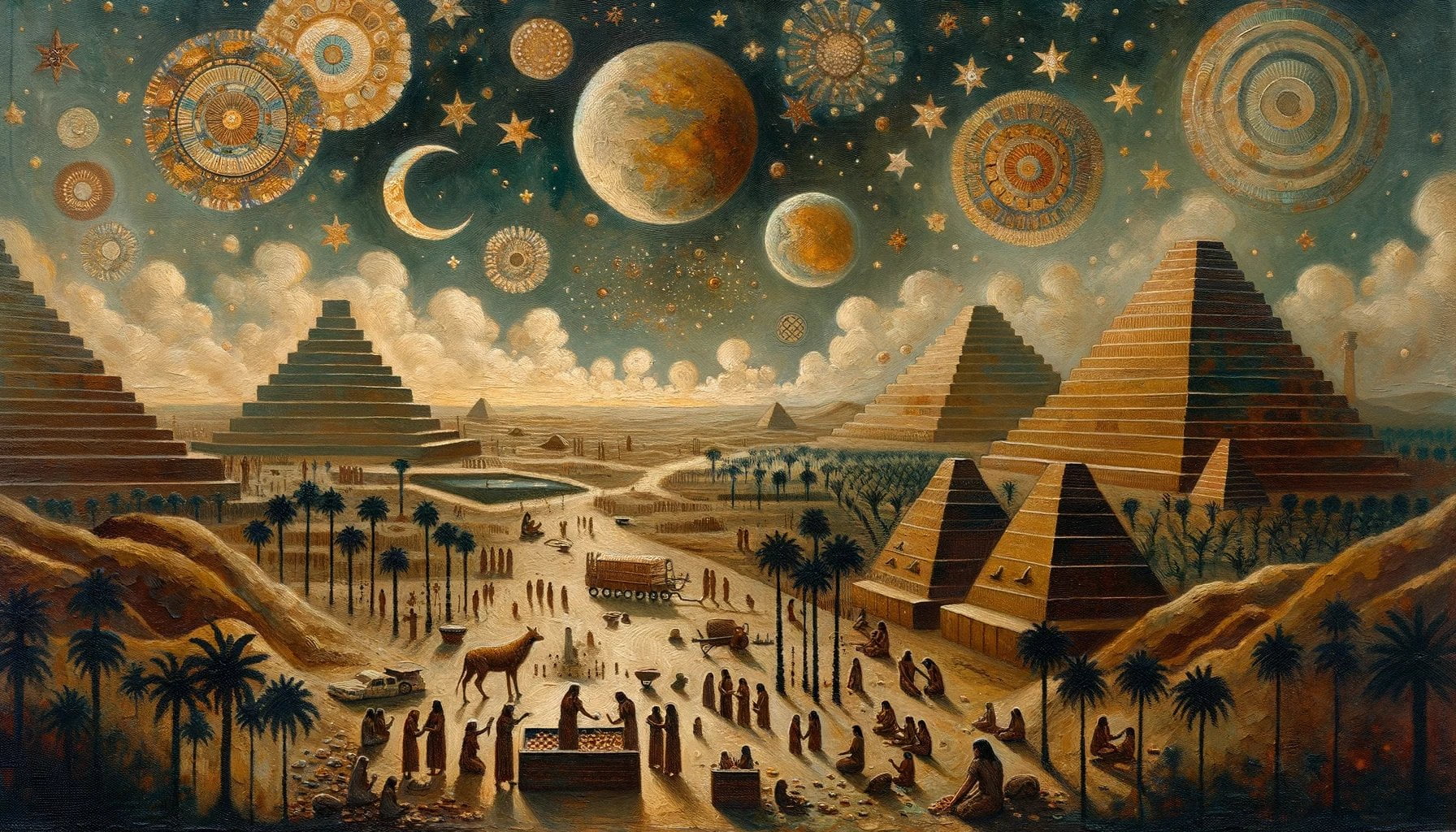
FAQ
Q1: What is Mesopotamian cosmology?
A1: Mesopotamian cosmology refers to the ancient beliefs and understanding of the creation, structure, and workings of the universe in Mesopotamian culture. It can be reconstructed from various sources such as mythology, hymns, celestial divination, and astronomical texts.
Q2: What is the Enuma Elish?
A2: The Enuma Elish is one of the most well-known Mesopotamian creation epics. It tells the tale of Marduk, the chief god of Babylon, who defeats the elder goddess Tiamat and brings order to chaos, establishing himself as the Lord of the Gods of Heaven and Earth.
Q3: What is the significance of creation myths in Mesopotamian cosmology?
A3: Creation myths play a vital role in Mesopotamian cosmology as they provide insights into the ancient beliefs and understanding of the origins of the universe. While not scientific explanations, these myths offer a cultural and symbolic interpretation of creation, shedding light on the ancient worldview.
Q4: What were the celestial objects studied in ancient Mesopotamia?
A4: In ancient Mesopotamia, all five planets visible to the naked eye, along with the Moon, the Sun, the stars, and other celestial phenomena, were known and studied. These objects were observed and their movements were often intertwined with astronomical, astrological, and religious practices.
Q5: How can we study Mesopotamian cosmology?
A5: Mesopotamian cosmology can be studied through various sources, including research articles, academic papers, and archaeological discoveries. Reconstruction of their cosmological beliefs is based on Sumerian and Akkadian mythology, hymns, celestial divination, and astronomical observations.


